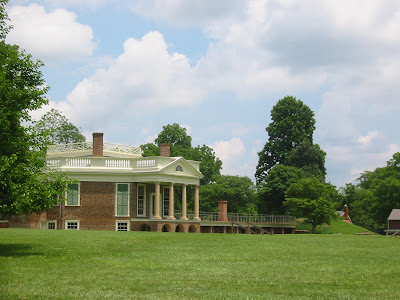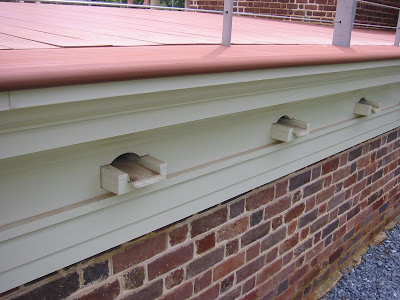Poplar Forest

This past weekend I went with my friend Janet (of JCB fame) and some friends to Poplar Forest, the country retreat of Thomas Jefferson.

Everyone is familiar with Monticello, in Charlottesville, VA. but not everyone knows his country home & plantation some 90 miles away. The house was built after Monticello, beginning in 1806, as a way to escape the crowds which gathered to hear him speak. Many of his architectural ideals were able to crystalize and work themselves out here and he fondly called it his most valuable posesssion. front porch detail
front porch detail
 front porch detail
front porch detail The house is in the form of an octagon, a shape Jefferson was obsessed with. On a practical level, it was a way to have the most surface area and windows for ventilation.

The building is a simple country house, meant as a private retreat, based on Palladian ideals. The center of the octagon shape is a dining room, a 20 foot cube which is lit by a large skylight. A double bed chamber for Jefferson (with the bed built into a nook between them, similar to Monticello and a favorite detail of mine) and 2 bedrooms for grandchildren flank the dining room, as does the salon and the small entry hall. These are the main areas of the house.

The grounds have been sold off over the years, but the views from the house make it appear as if the original 4,800 acres are still intact. As the long journey took 3 days, Jefferson would retire here for long weeks at a time - his favorite activity was to study and read. Even the 2 outhouses, which symmetrically flank the main house, are octagons. This one below has some servants quarters which were built in the late 19th century which I believe are going to be removed.
Even the 2 outhouses, which symmetrically flank the main house, are octagons. This one below has some servants quarters which were built in the late 19th century which I believe are going to be removed.
 Even the 2 outhouses, which symmetrically flank the main house, are octagons. This one below has some servants quarters which were built in the late 19th century which I believe are going to be removed.
Even the 2 outhouses, which symmetrically flank the main house, are octagons. This one below has some servants quarters which were built in the late 19th century which I believe are going to be removed.
The house is a fascinating place, not just for the history,but for what is being undertaken at the moment. Subsequent owners and fires have modified the house to the point where it was barely recognizable to its original form. The organization managing the property has gutted it down to its structural brick which make up the exterior and even interior walls. It is being rebuilt using the same tools and techniques available to Jefferson at the time.

A large portion of the tour is showing the layers of construction and what goes into the process. I would highly recomend this to any architecture student (or architect) as a really fascinating look into how building technology has changed. They really are doing an excellent job of portraying the construction: Trust me, it's not boring! I can't wait to go back in a few years and see the progress!  These scuppers (or roof drains) got water off the service wing roof (known as the office) which housed the kitchens and allowed the surface to be a deck for Jefferson and his grandchildren to use as a promenade. An example of how it was constructed lays in the wing below.
These scuppers (or roof drains) got water off the service wing roof (known as the office) which housed the kitchens and allowed the surface to be a deck for Jefferson and his grandchildren to use as a promenade. An example of how it was constructed lays in the wing below.
 These scuppers (or roof drains) got water off the service wing roof (known as the office) which housed the kitchens and allowed the surface to be a deck for Jefferson and his grandchildren to use as a promenade. An example of how it was constructed lays in the wing below.
These scuppers (or roof drains) got water off the service wing roof (known as the office) which housed the kitchens and allowed the surface to be a deck for Jefferson and his grandchildren to use as a promenade. An example of how it was constructed lays in the wing below.
Visit the main website to plan your visit HERE

This entry was posted on October 4, 2009 at 12:14 pm, and is filed under
Architect,
DC,
history,
Washington
. Follow any responses to this post through RSS. You can leave a response, or trackback from your own site.
Subscribe to:
Post Comments (Atom)









Post a Comment